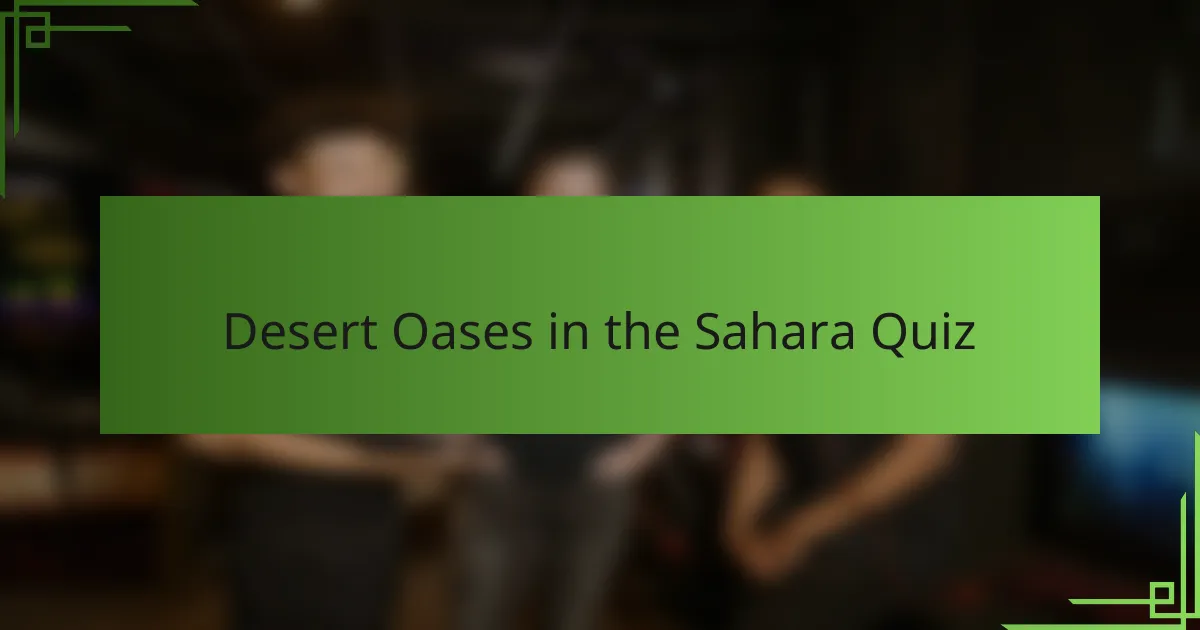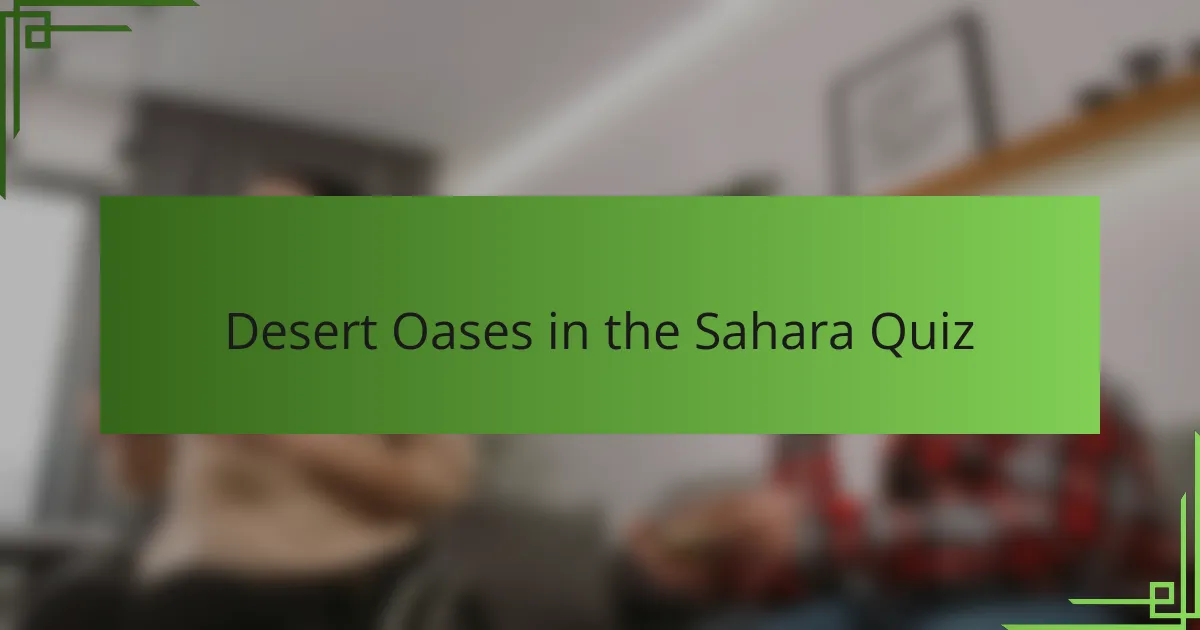
Desert Oases in the Sahara Quiz
1. What is the name of the largest oasis in the Sahara Desert, located in southwestern Libya?
- Murzuq Oasis
- Ghadames Oasis
- Jaghbub Oasis
- Ubari Oasis
2. Which oasis in Algeria is known for its extensive date palm plantations and historical ksar architecture?
- Timimoun
- Biskra
- Ouargla
- Ghardaïa
3. The Siwa Oasis, famous for its unique culture and ancient ruins, is located in which country?
- Sudan
- Libya
- Algeria
- Egypt
4. What is the main water source that sustains the Awjila Oasis in eastern Libya?
- Underground volcanic springs
- The Nile River
- Fossil groundwater from the Nubian Sandstone Aquifer System
- Seasonal mountain snowmelt
5. Which oasis served as an important caravan stop on trans-Saharan trade routes in Niger?
- Zinder
- Tenere
- Timbuktu
- Agadez
6. The town of Timimoun is associated with which prominent oasis in Algeria?
- M`Zab
- Tassili n`Ajjer
- Gourara
- Hoggar
7. What natural feature typically characterizes a Sahara desert oasis such as the Kufra Oasis?
- A vast network of sand dunes
- A seasonal riverbed
- A large salt flat
- A natural spring or groundwater source
8. Which oasis in Tunisia is renowned for its unique Saharan flora and traditional Berber culture?
- Douz
- Ksar Ghilane
- Tozeur
- Matmata
9. The desert oasis of Ghadames is located in which country and is famous for its UNESCO-listed old town?
- Algeria
- Libya
- Tunisia
- Egypt
10. Which oasis in Morocco`s Sahara region is known for its proximity to the Erg Chebbi sand dunes?
- Zagora
- Erfoud
- Tinerhir
- Merzouga
11. What role do underground aquifers play in sustaining the Huacara Oasis in the Sahara?
- They function as channels that direct surface water from distant rivers directly into the oasis.
- They influence the oasis by storing saline water that supports salt-tolerant plant species.
- They primarily serve as underground storage for rainwater, occasionally releasing it during seasonal floods.
- They provide a continuous source of freshwater that allows vegetation and human settlement to thrive in the Huacara Oasis.
12. The oasis town of In Salah in Algeria is notable for its natural gas fields and what type of geographic feature?
- Sahara Desert
- Atlas Mountains
- Mediterranean Coastline
- Erg Sand Dunes
13. Which palm tree species predominates in the date groves of the Figuig Oasis on the Algerian-Moroccan border?
- Sabal palmetto
- Elaeis guineensis
- Phoenix dactylifera
- Washingtonia robusta
14. What is the primary economic activity in the Siwa Oasis of Egypt related to its desert environment?
- Mining of desert minerals
- Nomadic herding of goats
- Date palm cultivation
- Oil extraction from desert plants
15. The town of Murzuk is associated with the Murzuk Oasis located in which desert region?
- Namib Desert
- Kalahari Desert
- Arabian Desert
- Sahara Desert

Congratulations on Completing the Desert Oases in the Sahara Quiz!
Thank you for taking the time to explore the fascinating world of desert oases in the Sahara through this quiz. We hope you enjoyed discovering how these rare and vital water sources support life in one of the harshest environments on Earth. Each question was designed to deepen your understanding of their geography, significance, and the delicate ecosystems they sustain.
Throughout the quiz, you might have learned about the formation of oases, their role in human settlement, and how they influence trade and culture in desert regions. Understanding these natural features helps us appreciate the complex interactions between climate, terrain, and living organisms in the Sahara. It also highlights the importance of conserving these precious habitats for future generations.
If you found this quiz insightful, be sure to check out the next section on this page. There, you will find more detailed information about Desert Oases in the Sahara, including maps, historical facts, and current environmental challenges. Expanding your knowledge further will enrich your appreciation of geography and the incredible resilience of life in extreme places.

Desert Oases in the Sahara
Geographical Definition and Importance of Desert Oases in the Sahara
A desert oasis in the Sahara is a fertile area within the arid desert terrain where water from underground sources surfaces, creating a microenvironment conducive to vegetation and human settlement. These oases interrupt the vast, barren Sahara Desert, providing essential water and resources in a predominantly dry region. Their existence is tied to underground aquifers or springs that supply the moisture necessary to sustain life. Oases have historical significance as stopover points for trade caravans and habitation sites, reflecting their crucial geographical role in desert ecosystems.
Hydrological Characteristics of Sahara Desert Oases
The oases in the Sahara are sustained primarily by phreatic water, which is groundwater stored in aquifers beneath the desert surface. Water emerges at these oases due to geological formations like faults or depressions that channel underground water to the surface. For example, the Siwa Oasis in Egypt and the Kufra Oasis in Libya rely on such hydrological phenomena. This supply of water creates wetlands and supports agriculture through irrigation, differentiating oases from surrounding arid land.
Distribution and Major Examples of Oases in the Sahara Desert
The Sahara hosts numerous significant oases scattered across its expanse. Notable examples include the Siwa Oasis in Egypt, known for its springs and rich history; the Kufra Oasis in southeastern Libya, a key location for nomadic tribes; and the Timimoun Oasis in Algeria, famous for its extensive date palm groves. These oases are often strategically located near mountain ranges or sandstone plateaus, where natural water recharge is more likely to occur, influencing their distribution.
Ecosystem and Vegetation Unique to Sahara Desert Oases
Sahara oases support unique ecosystems distinct from the surrounding desert. Date palms (Phoenix dactylifera) dominate these areas due to their adaptability to arid climates and reliance on groundwater. Other vegetation includes acacia trees and various shrubs adapted to limited water availability. This vegetation creates microhabitats that sustain diverse fauna and contribute to soil stability. The specialized plant life evidences the presence of consistent water sources and shapes the human use of the land for agriculture.
Human Settlement and Geographic Impact of Oases in Sahara
Human settlements in the Sahara frequently cluster around oases due to their vital water resources. Communities such as those in the Tamanrasset region of Algeria and Ghat in Libya have developed around these water points. Oases enable agriculture, trade, and cultural exchanges. Their geographic impact includes the establishment of caravan routes connecting sub-Saharan Africa with North Africa, facilitating commerce and migration. The spatial pattern of Saharan oases illustrates their role as lifelines in the desert environment.
What are desert oases in the Sahara?
Desert oases in the Sahara are fertile areas found in the desert where water is naturally available, allowing vegetation and human settlement. They form when underground water reaches the surface through springs or wells, creating a habitable environment surrounded by the arid Sahara Desert. These oases are crucial for supporting life within the vast desert expanse.
How do desert oases form in the Sahara?
Desert oases in the Sahara form through the natural emergence of groundwater, often from deep aquifers or wadis, surfacing due to geological conditions like faults or depressions. This water availability sustains plant growth and human activity. The presence of such groundwater is often due to ancient rainfall or distant recharge areas replenishing underground reservoirs.
Where are the most notable desert oases located in the Sahara?
The most notable desert oases in the Sahara include Siwa Oasis in Egypt, Kufra Oasis in Libya, and Timimoun in Algeria. Siwa Oasis is famous for its extensive springs fed by a deep aquifer. Kufra Oasis is a vital water source in southeastern Libya, supporting a community despite the extreme surrounding desert. Timimoun is known for its red sandstone cliffs and palm groves sustained by groundwater.
When did human settlement begin around Sahara oases?
Human settlement around Sahara oases began thousands of years ago, dating back to the Neolithic period about 8,000 to 12,000 years ago. Archaeological evidence from places like the Siwa Oasis shows early humans used these water sources for agriculture and habitation, enabling civilization to survive in an otherwise harsh desert environment.
Who relies on desert oases in the Sahara for survival?
Nomadic and settled communities, such as the Tuareg and Berber peoples, rely on Sahara desert oases for survival. These oases provide water, food, and trade routes essential to their livelihoods in the desert. Oases also support agricultural activities like date palm cultivation, which sustains local populations culturally and economically.
